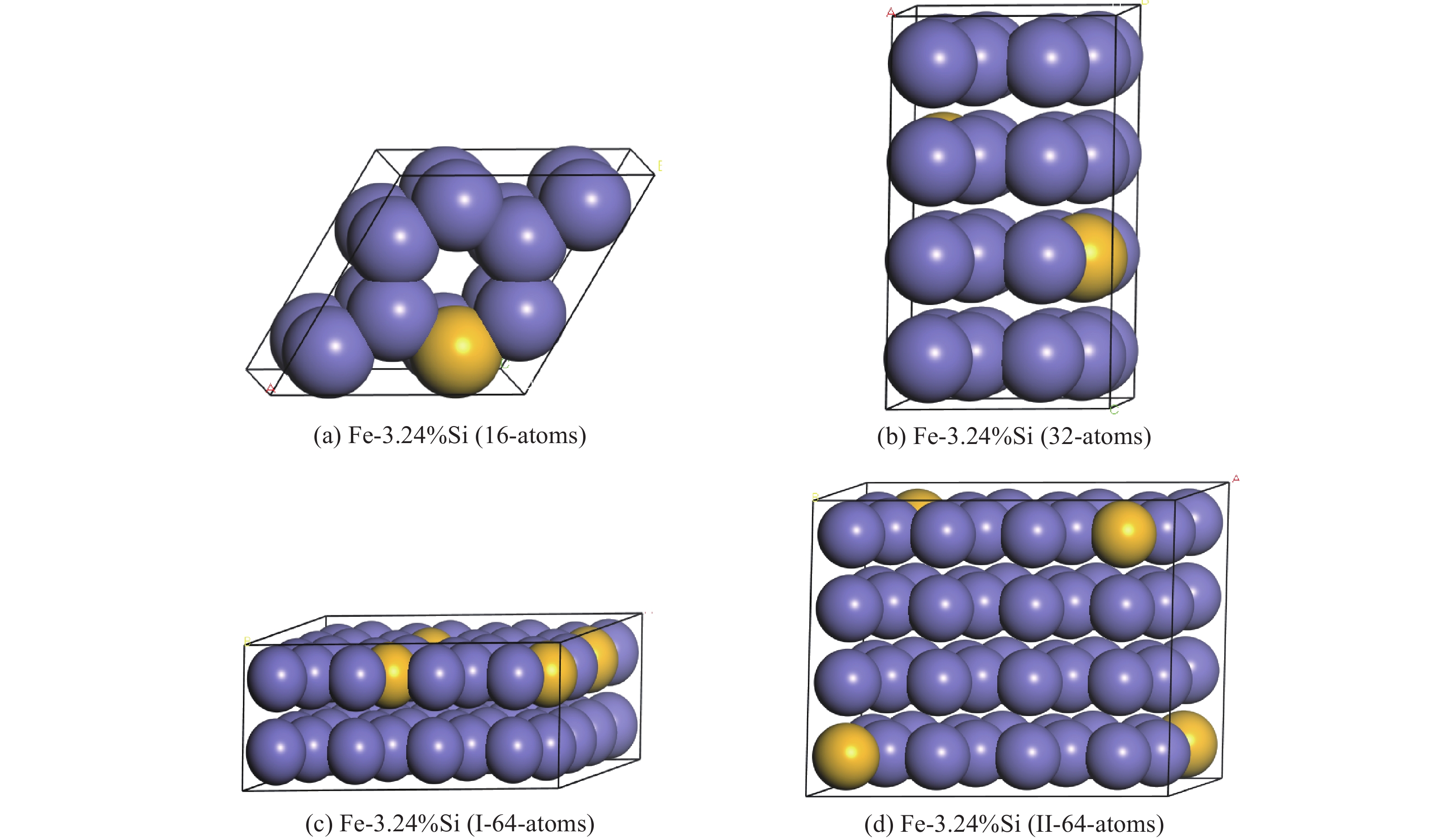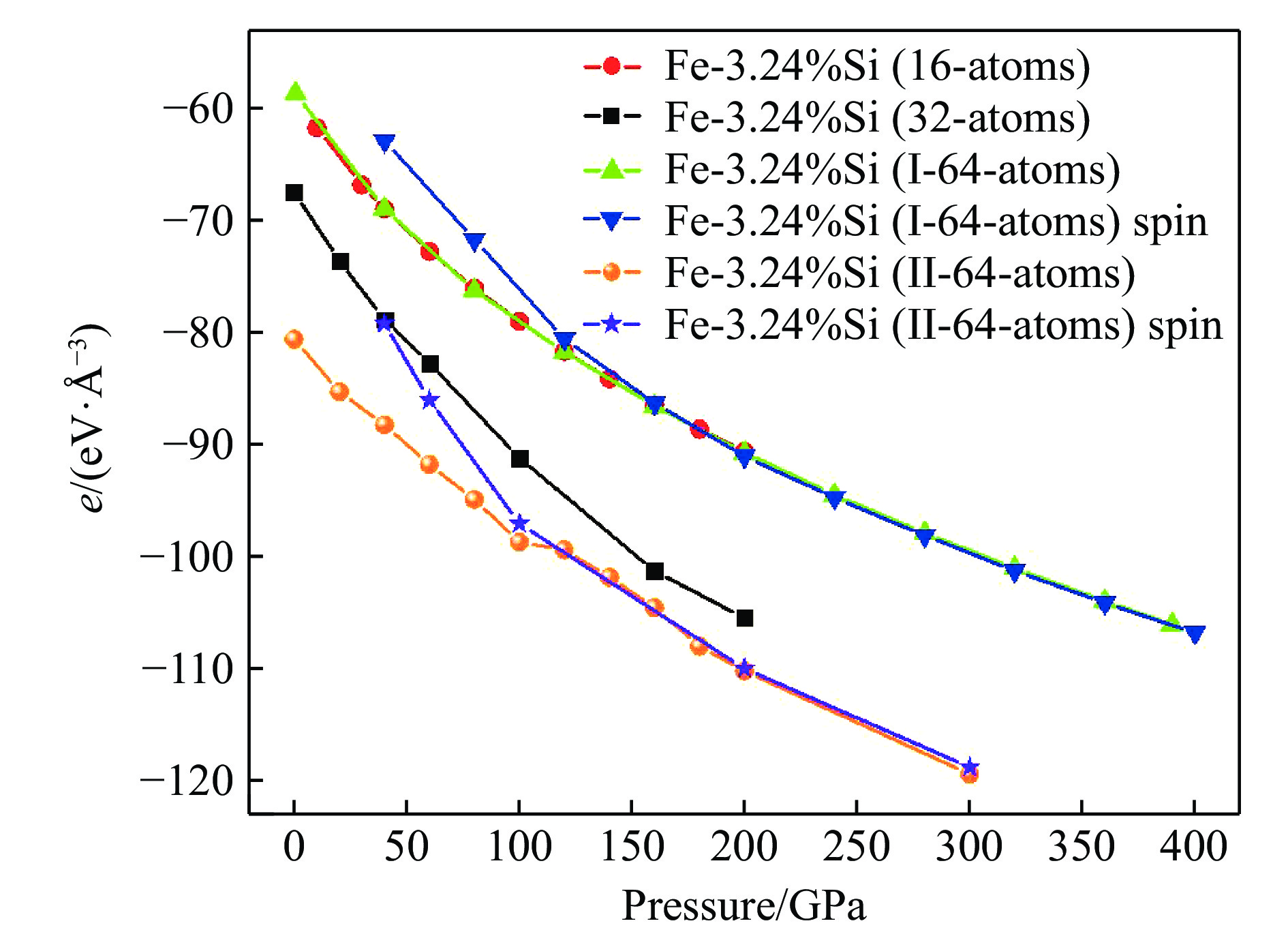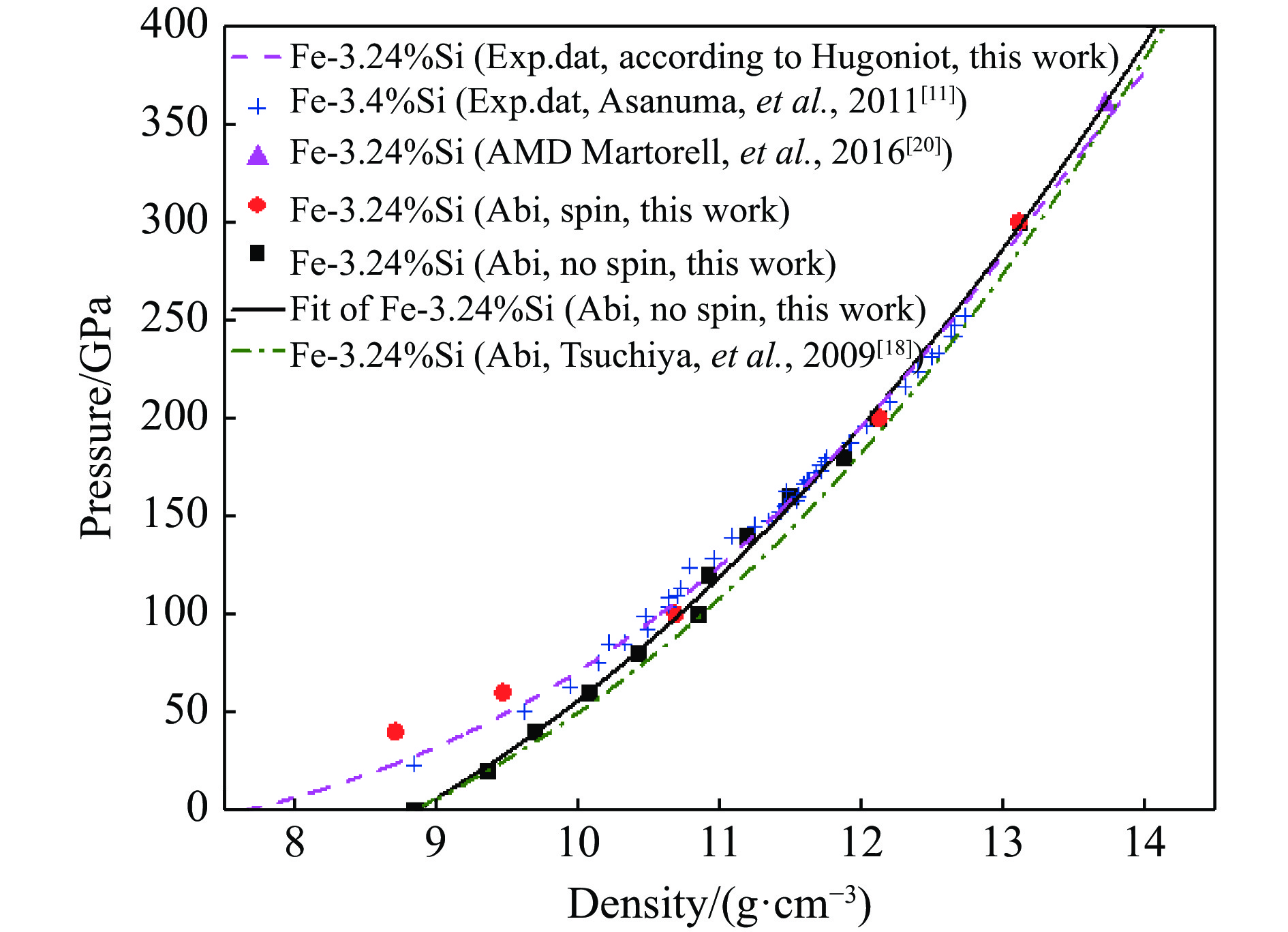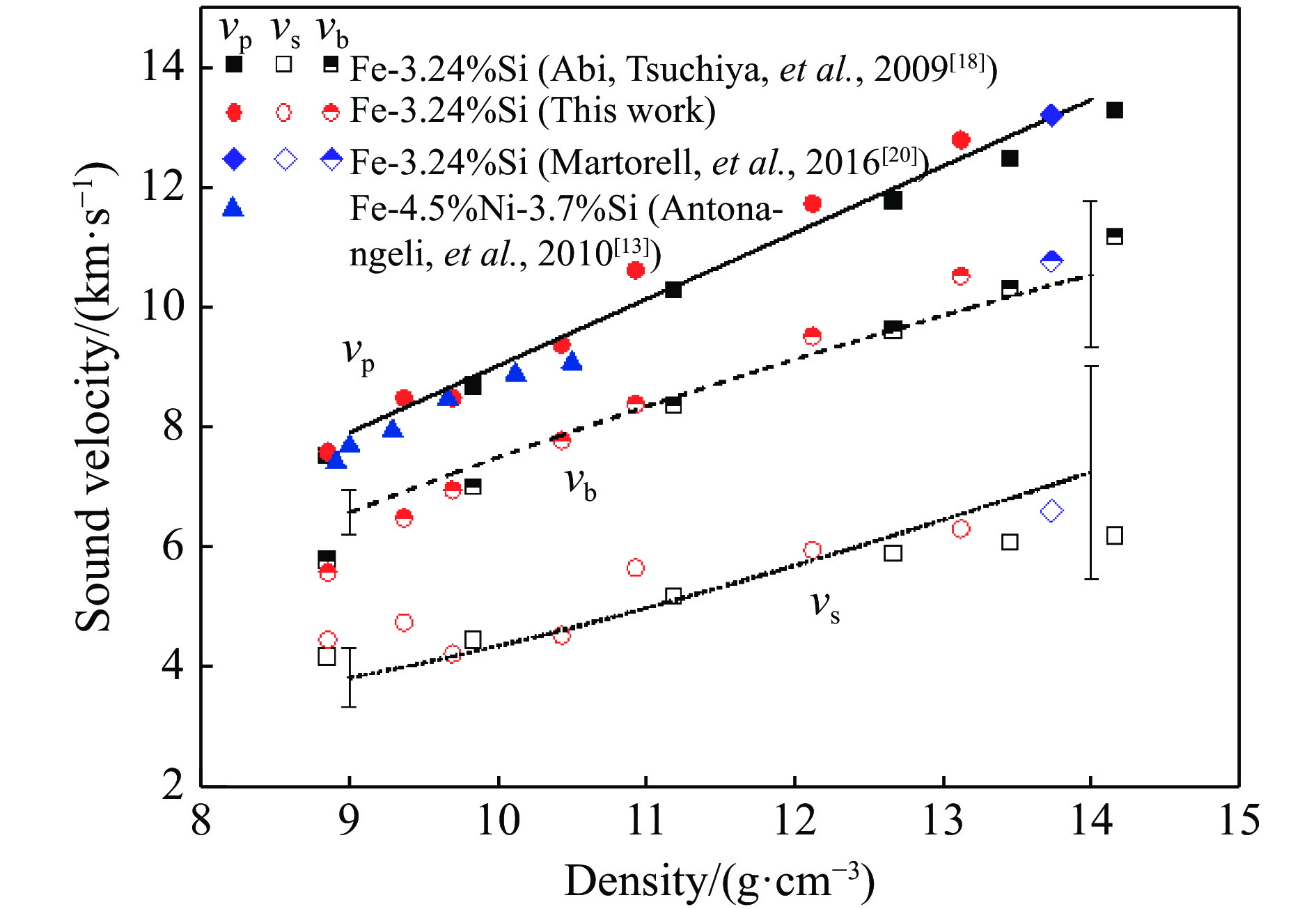-
基于地球物理、地球化学和冶金学的研究,现已确定地核由铁和少量轻元素组成,如氧(O)、硫(S)、硅(Si)、碳(C)和氢(H)[1]。由于Si在地球中的含量非常高[1-2],高温高压下在铁中的溶解度也很高[3-7],并且铁与硅酸盐反应会生成硅铁合金[8-9],因此Si被认为是地核中的主要轻元素。
目前,有关Si元素在内地核中的含量(以下如无特别说明,均为质量分数)仍然存在争议。例如:Lin等[10]测量了300 K下Fe-Si体系的状态方程,认为内核中存在约4%的Si;Asanuma等[11]分别测量了hcp-Fe0.93Si0.07在374 GPa和hcp-Fe0.83Ni0.09Si0.08在252 GPa压力下的状态方程,并由此预测内地核中含有3.9%~5.8%的Si;基于实验数据和第一性原理计算结果,Fischer等[5]认为内地核中Si的含量为6%~8%;Tateno等[6]根据实验测量结果推测内核中含有约7%的Si。
地核中的候选轻元素除了满足密度约束条件外,还应满足声速的约束条件。2007年,Badro等[12]采用非弹性X射线散射技术(Inelastic X-ray Scattering,IXS)对FeSi在78 GPa下的声速进行研究,预测内地核中Si的含量为2.8%。Antonangeli等[13]使用相同的技术对Fe0.89Ni0.04Si0.07在108 GPa下的声速进行研究,认为内地核中Si的含量为1%~2%。2012年,Mao等[14]采用IXS和X射线衍射(X-Ray Diffraction,XRD)技术对hcp-Fe和hcp-Fe0.85Si0.15的声速进行研究,估测内地核中Si的含量为8%。Liu等[15]分别测量了206 GPa以内hcp-Fe和136 GPa以内hcp-Fe86.8Ni8.6Si4.6的声速,认为内地核中Si的含量为2.3%。最近,Sakairi等[16]通过高压实验研究了hcp-Fe0.89Si0.11(Fe-6%Si)的声速,指出内核中存在3%~6%的Si。Antonangeli等[17]测量了300 K下hcp-Fe和hcp-Fe-9%Si在高压下的声速,认为内核的Si不超过(3±2)%。受实验技术的限制,上述声速测量所能达到的温度和压强条件远小于内地核的温压环境,因此在外推过程中不可避免地引入了误差。
基于密度泛函的第一性原理计算方法将不受上述条件的约束。Tsuchiya等[18]应用第一性原理方法计算了Fe-3.24%Si在0 K时的弹性常数,发现fcc (面心立方)结构和hcp(六方密堆积)结构的密度-速度关系与内地核数据一致。同样,运用第一性原理计算方法,Côté等[19]发现Fe-Si合金的结构与Si的含量有关:当Si的含量小于7%时,Fe-Si合金的结构为hcp结构;当Si的含量超过7%且温度高于4 000 K时,Fe-Si合金为fcc结构。Martorell等[20]计算了360 GPa时不同温度下的声速,认为Si不可能是内地核中的主要轻元素。综上所述,内地核中Si元素的含量还存在较大的争议,需要进一步开展理论和实验研究。
全文HTML
-
本研究采用第一性原理计算方法对Fe-3.24%Si(Si的质量分数为3.24%)的状态方程和声速进行研究。计算中,将密度泛函理论(DFT)[21]的第一性原理计算方法与赝势平面波法相结合,交换关联能(XC)[22-23]采用Perdew-Burke-Ernzerh(PBE)的广义梯度近似(GGA)[24-25]。采用超软赝势(USPP)[26],其中截断能为380 eV,k点的设定为7×7×4。能量收敛精度为1.0×10–5 eV/atom,原子间作用力的收敛精度为0.03 eV/Å,原子间应力收敛精度为0.05 GPa,原子的最大允许位移为0.001 Å。基于上述参数,计算了0 K时不同压力下hcp-Fe-3.24%Si的密度和弹性常数。
本研究基于应力和应变的关系获得了弹性常数[27]。根据晶体弹性力学相关理论,应力和应变之间的关系为
弹性常数矩阵有36个弹性常数。根据晶体的对称性,弹性常数矩阵可以简化为
设零压p0下的晶体体积为V0。在本工作中,铁硅合金为六角立方结构。Voigt[28]认为体积模量KV和剪切模量GV可表示为
Reuss[29]提出的体积模量KR和剪切模量GR分别为
式中:M和C分别表示为
而Hill[30]认为晶体中应力和应变分布不均匀,其体积模量KH和剪切模量GH应为Voigt和Reuss建议的平均值,即
在固体中,横波声速vs、纵波声速vp及体波声速vb与体积模量和剪切模量的关系为
式中:
$ \rho$ 为密度。
-
优化了4种不同结构的hcp-Fe-3.24%Si,通过比较能量,得到最接近实际值的结构(II-64-atoms)。基于第一性原理计算的状态方程和声速,计算了内核温压条件下的密度和声速,以此限定内核中Si的含量。
-
考虑4种不同结构的hcp-Fe-3.24%Si(Fe0.937 5Si0.062 5),即2×2×2(16-atoms)、2×2×4(32-atoms)、4×2×4(I-64-atoms)和4×2×4(II-64-atoms),如图1所示,其中:4×2×4(I-64-atoms)的超晶胞是4个Si原子均匀分散在64个Fe原子内,4×2×4(II-64-atoms)结构是4个Si原子处于64个Fe原子中最分散的位置。这4种Fe-3.24%Si结构均在基态下进行了优化,并考虑了自旋的影响。根据每一单位体积的能量,可以选出最稳定的结构,如图2所示。当压强低于100 GPa时,II-64-atoms具有最低能量;当压强高于100 GPa时,自旋对II-64-atoms结构的能量无影响,因此单位体积内II-64-atoms具有最低的能量,即此结构最稳定。
-
沿0 K等温线,用第一性原理方法计算得到状态方程,如图3所示,其中红色实心圆和黑色实心方块分别代表Fe-3.24%Si有自旋和无自旋计算结果。当压强低于100 GPa时,Fe-3.24%Si有自旋时的密度高于无自旋时的密度,并且更接近实验数据,表明低压时必须考虑电子自旋的影响。其他研究工作[31-33]也表明,当压强低于约60 GPa时,有自旋状态比无自旋状态更稳定。当压强高于100 GPa时,与Asanuma等[11]通过实验测量的Fe-3.4%Si的实验数据一致,并且有无自旋对计算结果无影响。将不考虑自旋的Fe-3.24%Si的计算结果用三阶Birch-Murnaghan状态方程(其中初始密度
$ {\rho _0}$ =(8.87±0.09) g/cm3)拟合得到零压下的体积模量K0=(368±38) GPa,其压力导数为
${K'_0}$ =3.72±0.31。将计算结果外推至330 GPa,与Martorell等[20]采用第一性原理分子动力学模拟的Fe-3.24%Si结果一致,但却略高于Tsuchiya等[18]用第一性原理计算方法得到的结果。图3也给出了根据Hugoniot数据计算的Fe-3.24%Si的300 K状态方程,计算方法如下。Mie-Grüneisen方程表示为
式中:
${p_{\rm{H}}}(V)$ 为Hugoniot状态方程。式中:C0和
$ \lambda $ 为Hugoniot参数。到目前为止,还未见发表Fe-3.24%Si的Hugoniot数据。为此,由纯铁的Hugoniot参数C0=3.935 km/s和$ \lambda $ =1.578,纯铁的初始密度$ {\rho _0}$ =7.85 g/cm3[34],以及Fe-9%Si的Hugoniot参数C0=(4.603±0.101) km/s,$ \lambda $ =1.505±0.037,Fe-9%Si的初始密度$ {\rho _0}$ =7.386 g/cm3[35],根据可加性原理[36]得到Fe-3.24%Si的Hugoniot数据式中:下标i代表i组分,wi是组分i的质量分数,V0为基态体积。根据(15)式,计算得到Fe-3.24%Si的Hugoniot参数为C0=4.182 km/s,
$ \lambda $ =1.551,以及0 K密度$ {\rho _0}$ =7.668 g/cm3。(13)式中的冲击温度可以通过下式估算式中:CVl代表晶格对定容比热容的贡献,简称晶格比热,在高温下CVl=3R/
$ \mu $ ,其中R为理想气体常数,摩尔质量$ \mu $ =54.11 g/mol;$ {C_{V{\rm{e}}}} = {\beta _0}{\left( {{\rho _{0\varepsilon }}/\rho } \right)^\kappa }T$ [37]为电子对定容比热容的贡献,简称电子比热。由于Fe-3.24%Si中Si的含量很小,因此假设其电子比热的参数和铁一致,即$ {\beta _0}$ =0.091 J·kg–1·K–2和$\kappa = 1.34$ [38]。另外,在本研究中还假设Fe-3.24%Si晶格和电子的Grüneisen参数都近似等于铁的相关参数$ {\gamma _{\rm l}} = 1.74{({\rho _{0\varepsilon }}/\rho )^{0.78}}$ [39]和$ {\gamma _{\rm e}}=2$ [40]。基于hcp-Fe-9%Si[6]在室温下的密度$ {{\rho _{0\varepsilon }}}$ =7.578 g/cm3和hcp-Fe[39]的密度$ {{\rho _{0\varepsilon }}}$ =8.269 g/cm3,通过内插法可估计出hcp-Fe-3.24%Si在室温下的密度$ {{\rho _{0\varepsilon }}}$ =7.995 g/cm3。将这些参数代入(13)式,计算得到Fe-3.24%Si在室温下的状态方程,如图3中品红色虚线所示,与Fe-3.4%Si的静高压数据一致[11],也与100 GPa以上的第一性原理计算结果一致。 -
由前面对比分析可知,当压强在100 GPa以上时,有无自旋对Fe-3.24%Si的状态方程无影响。考虑计算资源的问题,本研究假设自旋对声速亦无影响,在此仅计算II-64-atoms结构在高压零温下的声速。Fe-3.24%Si[18, 20]的纵波声速vp与密度呈线性关系(见图4)
也就是说,Fe-3.24%Si的纵波声速vp在室温下满足Birch定律[41]。在低压下,所有Fe-3.24%Si的计算结果与实验测量的Fe-4.5%Ni-3.7%Si的纵波声速vp一致[13]。对于体波声速vb,本研究通过第一性原理得到的计算结果与Tsuchiya等[18]和Martorell等[20]计算的体波速度vb比较吻合。基于之前计算Fe-3.24%Si状态方程的方法,还可以根据热力学方法估算体波速度
0 K下,根据(20)式计算的体波速度vb在低压下略高于根据(11)式得到的vb,并且两者的差异在误差范围内,高压下计算得到的vb一致。因此,可以用(20)式估算内核高温高压条件下的体波速度vb。由(19)式和(20)式,计算得到的横波声速vs如下
在误差范围内,由(21)式计算的横波声速与由(10)式得到的横波声速相近。根据状态方程和纵波声速的拟合结果,vb和vs的相对误差分别约为11%和24%。
-
根据0 K的状态方程和相应的热力学参数,可以通过下式计算内核条件下Fe-3.24%Si的密度
内地核温度剖面
$ {T_{\rm{E}}} = {T_{{\rm{ICB}}}}{\left( {\rho /{\rho _{{\rm{ICB}}}}} \right)^{1.5}}$ 可根据内外核边界处的温度TICB=(5 400±300) K[42-43]计算。对于纵波声速,前面的计算结果表明Fe-Si体系的纵波声速在室温下满足Birch定律,在高温高压下是否依然呈线性关系还存在争论[44]。Antonangeli等[45]在低于93 GPa、不高于1 100 K的温压范围内测量了Fe的声速,结果表明Fe的纵波声速在1100 K下仍然满足Birch定律。然而,Lin等[46]、Mao等[14]和Sakamaki等[47]的研究结果表明Fe的纵波声速在高温下与密度不再呈线性关系,意味着Birch定律在高温条件下并不成立。2017年,冯磊[35]应用动高压实验技术研究了Fe-9%Si在216 GPa、4 420 K时的纵波声速,测量数据与300 K下Fe-9%Si[17]的纵波声速非常一致,表明Fe-9%Si的纵波声速在高温高压下仍然满足Birch定律。在内地核高温高压条件下,假设Fe-3.24%Si的纵波声速仍然满足Birch定律,则其体波声速和横波声速可由(20)式和(21)式计算,结果如图5所示。为了研究Si对Fe的密度和声速的影响,还计算了内核条件下铁的密度和声速。铁的密度可由(13)式计算,其体积模量为K0=(172.7±1.4) GPa,${K'_0}$ =4.79±0.05,初始密度$ {\rho _0}$ =8.269 g/cm3[39];铁的纵波声速$ {v_{\rm{p}}} = (1.206\rho - 4.000)$ km/s[17]。在内核条件下,Fe-3.24%Si的密度低于Fe的密度,略高于内核的密度,表明Si降低了铁的密度。Fe-3.24%Si的纵波声速与铁的纵波声速接近,表明Si对铁的纵波声速的影响很小。Martorell等[20]的计算结果也支持这一结论,尽管他们认为温度会降低Fe和Fe-Si合金的纵波声速。Fe-3.24%Si的体波速度与PREM数据一致,并且高于铁;而Fe-3.24%Si的横波声速略低于Fe,但是均明显高于内地核的横波声速。由此可见,Si对铁的纵波声速和横波声速的影响较小。由于纯铁的声速明显高于内地核的声速,因此内地核中不可能含有大量的Si,而应含有能明显降低Fe的密度和声速的轻元素,如C[48-49]。
2.1. 几何结构优化
2.2. 0 K下hcp-Fe-3.24%Si的密度
2.3. 高压下hcp-Fe-3.24%Si的声速
2.4. 内地核中Si含量的限定
-
研究了0 K下Fe-3.24%Si的状态方程,并将其与静态高压实验数据、理论计算和动态高压实验数据进行了比较,研究发现:当压强高于100 GPa时,自旋对计算结果没有影响;在低压条件下考虑自旋时,其计算结果更接近实验值。通过计算弹性常数,得到了Fe-3.24%Si的纵波声速、横波声速和体波声速,发现根据第一性原理计算的纵波声速与Fe-4.5%Ni-3.7%Si的实验测量结果一致,并且满足Birch定律。
基于由第一性原理方法计算的状态方程和声速,利用热力学方法,计算了内地核温压环境下Fe-3.24%Si的密度和声速,并与内地核的密度和声速进行对比,发现:Fe-3.24%Si的密度高于PREM模型给出的内地核密度,但明显低于纯铁的密度;Fe-3.24%Si的纵波和横波声速接近Fe的声速,但是明显高于内地核的声速。由此排除了内地核含有大量Si元素的可能性。

 首页
首页 登录
登录 注册
注册





 下载:
下载:




